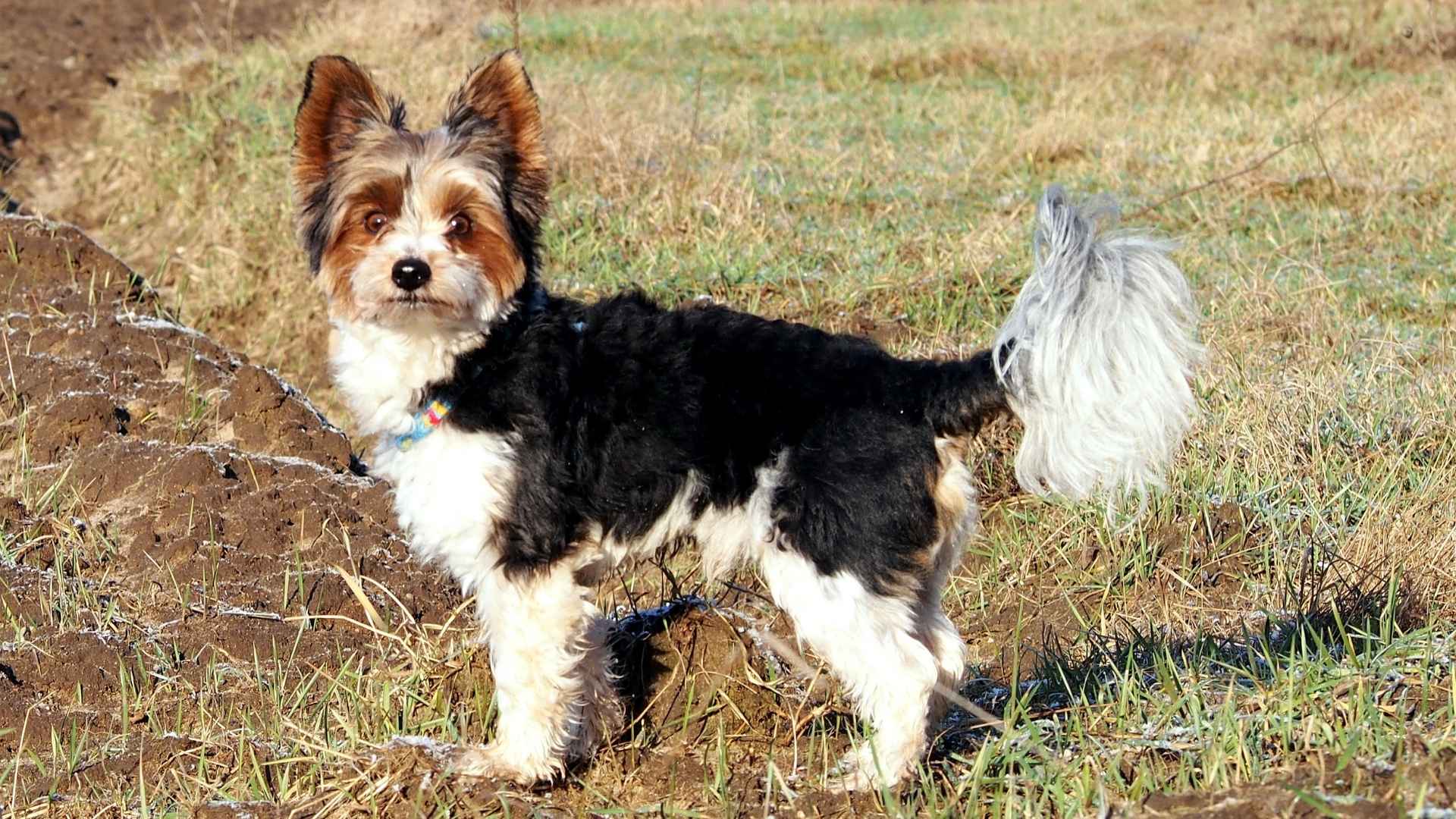Not everything popular is the best. The most-streamed song isn’t always the one that touches you. The most followed account doesn’t always share anything new. The same is true for dogs.
Small breeds like Chihuahuas, Pomeranians, and Dachshunds dominate conversations because they’re everywhere, but “everywhere” doesn’t mean exceptional. Sometimes, the real standouts are the ones that never got that chance in the spotlight.
They’re just as loyal, just as adorable, and sometimes—shockingly—much easier to live with. But you won’t find them in your average pet store window. And that’s exactly what makes them special. They haven’t been overbred, overmarketed, or turned into trends. They’re quiet, charming, and full of character.
If you’ve always had an eye for the uncommon, then what follows next isn’t just another list. It’s a small tribute to the kinds of dogs that stand out without ever trying to.
Rare Small Dog Breeds
1. Affenpinscher
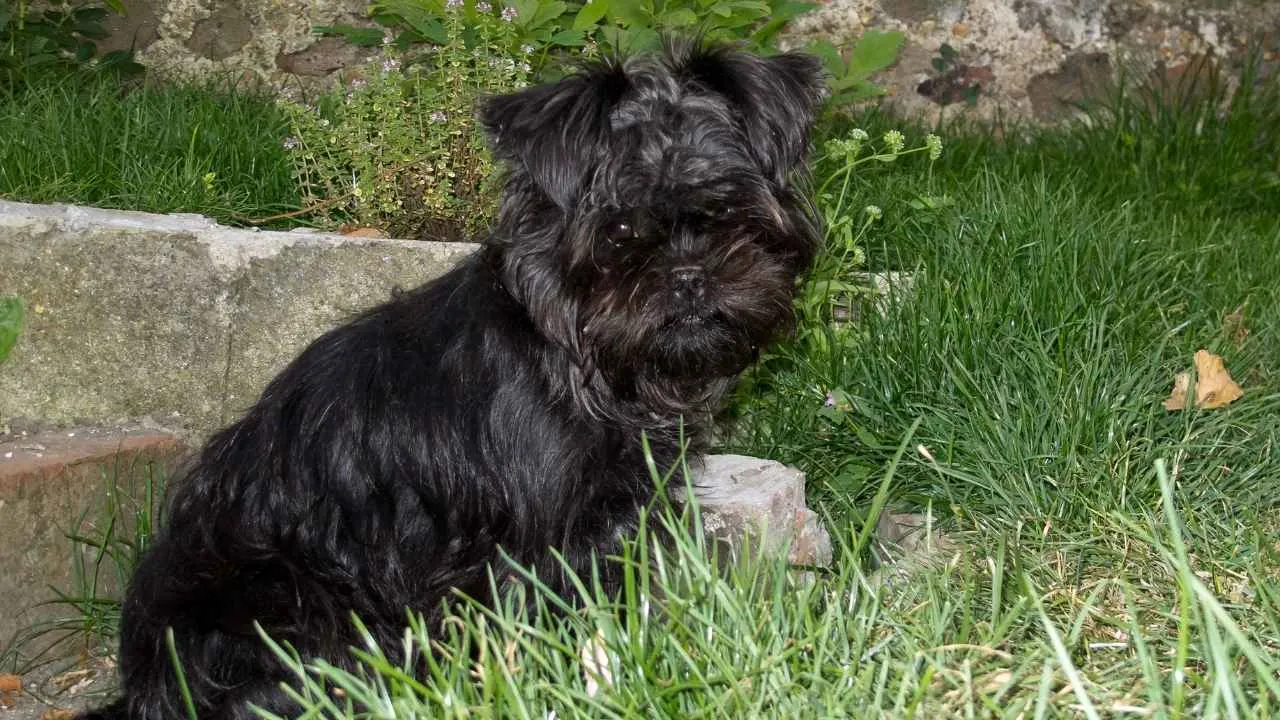
The Affenpinscher isn’t just small — it’s built for sharp reactions and quick decisions. Originally developed to keep stables and kitchens rodent-free, it still carries that intense, no-nonsense energy. Its compact frame hides a surprisingly assertive watchdog instinct.
Scruffy face, serious personality
Behind its famously monkey-like expression is a dog that takes itself seriously. It has an independent streak and reacts fast to anything that disrupts its space, as Zealandia Pets claims. That expressive face isn’t just for show—it constantly scans the room, always on alert.
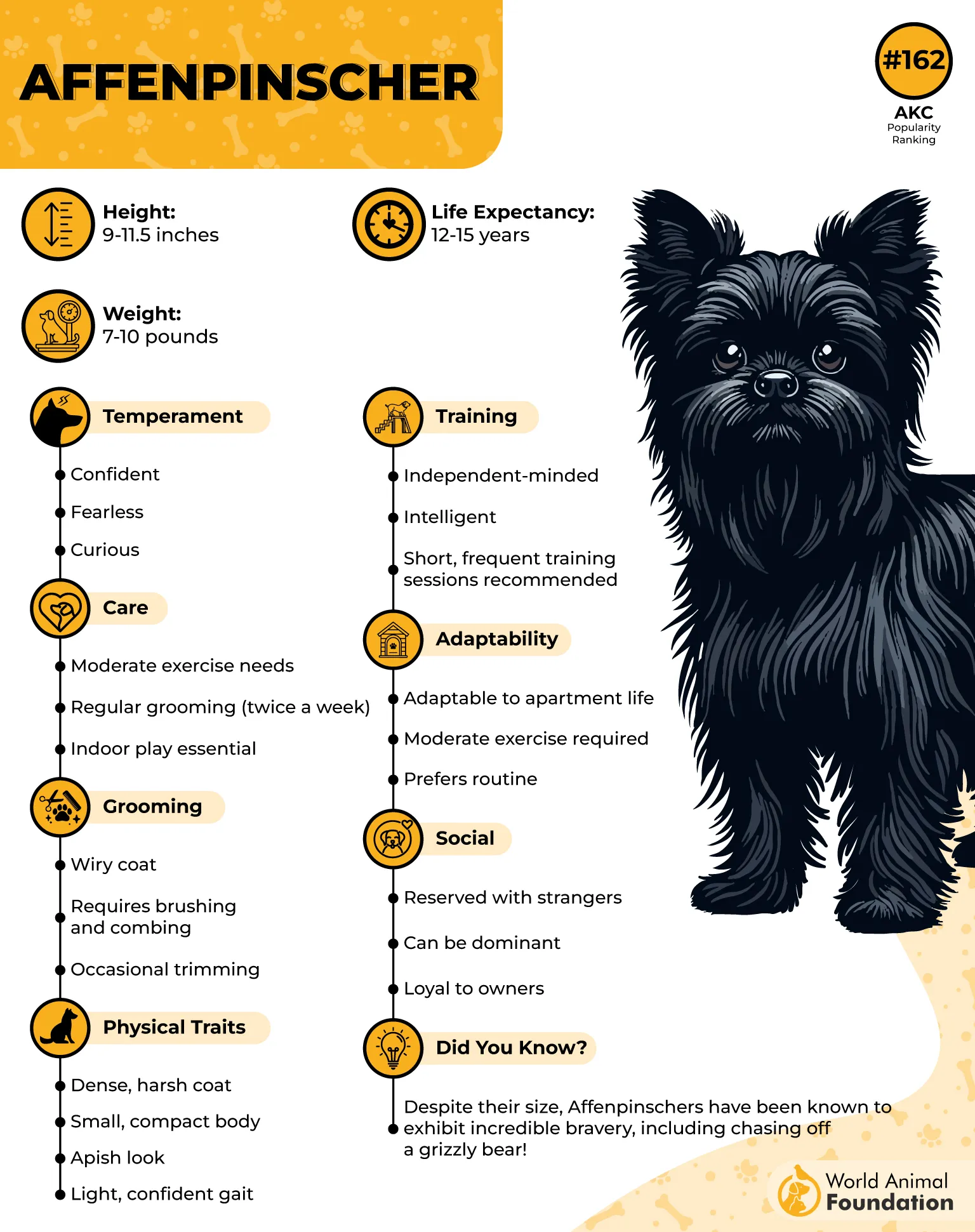
Surprisingly agile for its size
Though it looks more ornamental than active, the Affenpinscher moves with confidence and ease. It may not be grouped with traditional athletic dogs, but it can leap and scramble with precision when it wants to. Agility drills and puzzle games hold their interest longer than basic walks.
A rare breed with strong opinions
As one of the rare breed options still relatively unknown outside of breed circles, it’s not commonly spotted at parks. It chooses when to be affectionate and when to observe from a distance. It’s more of a thinker than a follower, which sets it apart in temperament.
2. Bedlington Terrier

The Bedlington Terrier’s curly coat and arched back give it a silhouette that’s often mistaken for a lamb, but its speed and intensity tell another story. The texture of the coat is a mix of hard and soft hairs, requiring regular trimming to maintain that classic shape. It doesn’t shed much but grows fast, demanding consistent grooming.
A sprinter in disguise
Despite the soft looks, it’s fast, really fast, as stated in Royal Canin. With surprisingly long legs and a light frame, the Bedlington can sprint like a coursing hound. It’s this athleticism that once made it a favorite in North England for hunting rabbits in tight spaces.
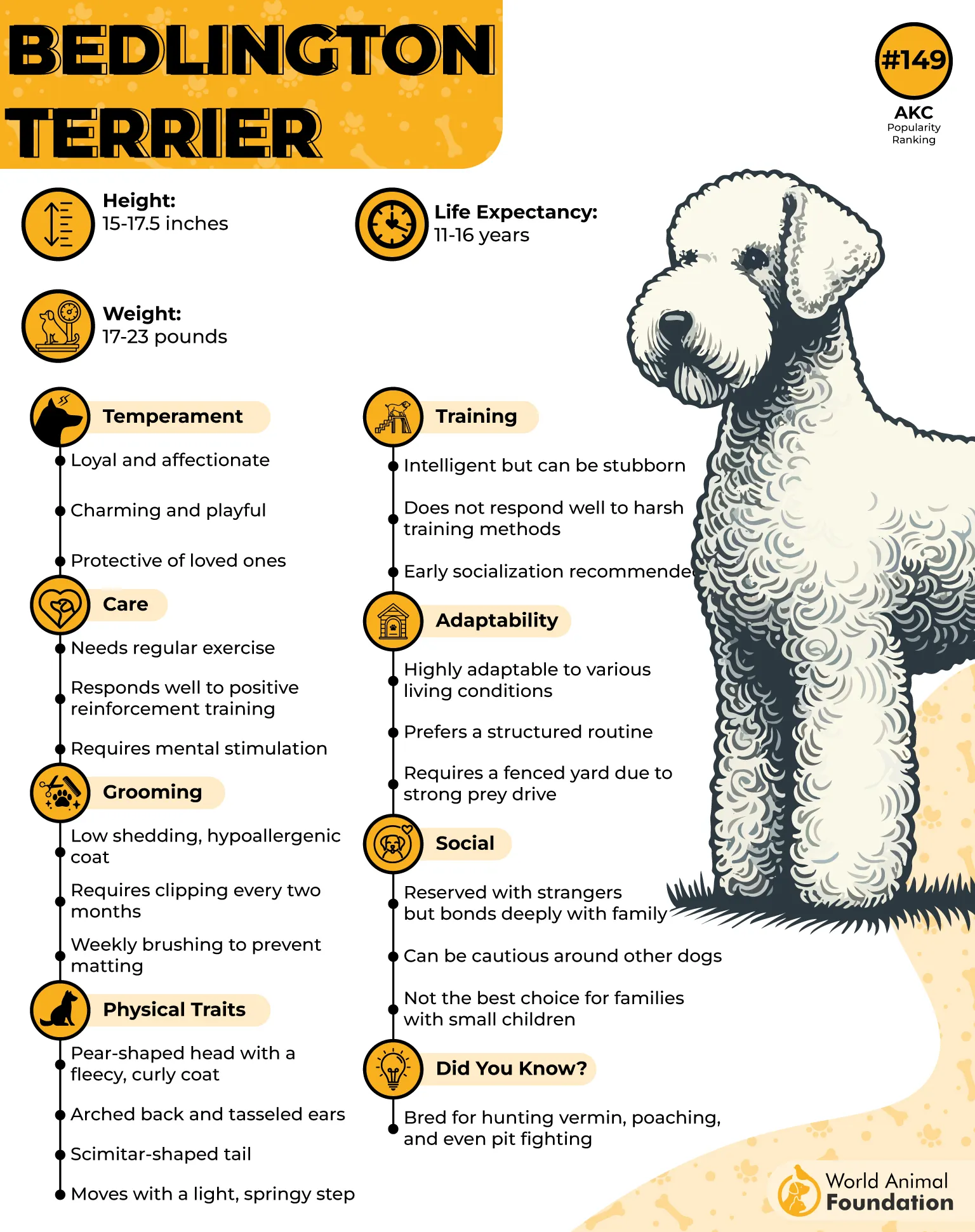
Sharp instincts, low tolerance for nonsense
This is not a dog that ignores what’s going on around it. It picks up sounds quickly and tends to be reactive when boundaries are crossed. While most dogs might overlook subtle shifts in the environment, the Bedlington is already a step ahead.
A rare dog with working roots
Though not commonly seen today, it’s a rare dog that was originally bred for both work and sport. It brings a level of grit and control to its movements that’s unexpected in a breed with such a delicate appearance. It doesn’t bark without purpose — it acts.
3. Biewer Terrier

The Biewer Terrier began as an accidental outcome of breeding in a Yorkshire Terrier bloodline in the 1980s in Germany, as highlighted in Petmojo. A unique piebald gene led to their distinct tricolor coats. This singular origin is precisely why they remain one of the most selectively bred rare dog breeds today.
Silky coat, steady disposition
Their fine, floor-length coat is part of their identity. Though they look dainty, Biewers are steady on their feet and rarely skittish indoors. The breed standard emphasizes not just coloring but also temperament: poised but not demanding.
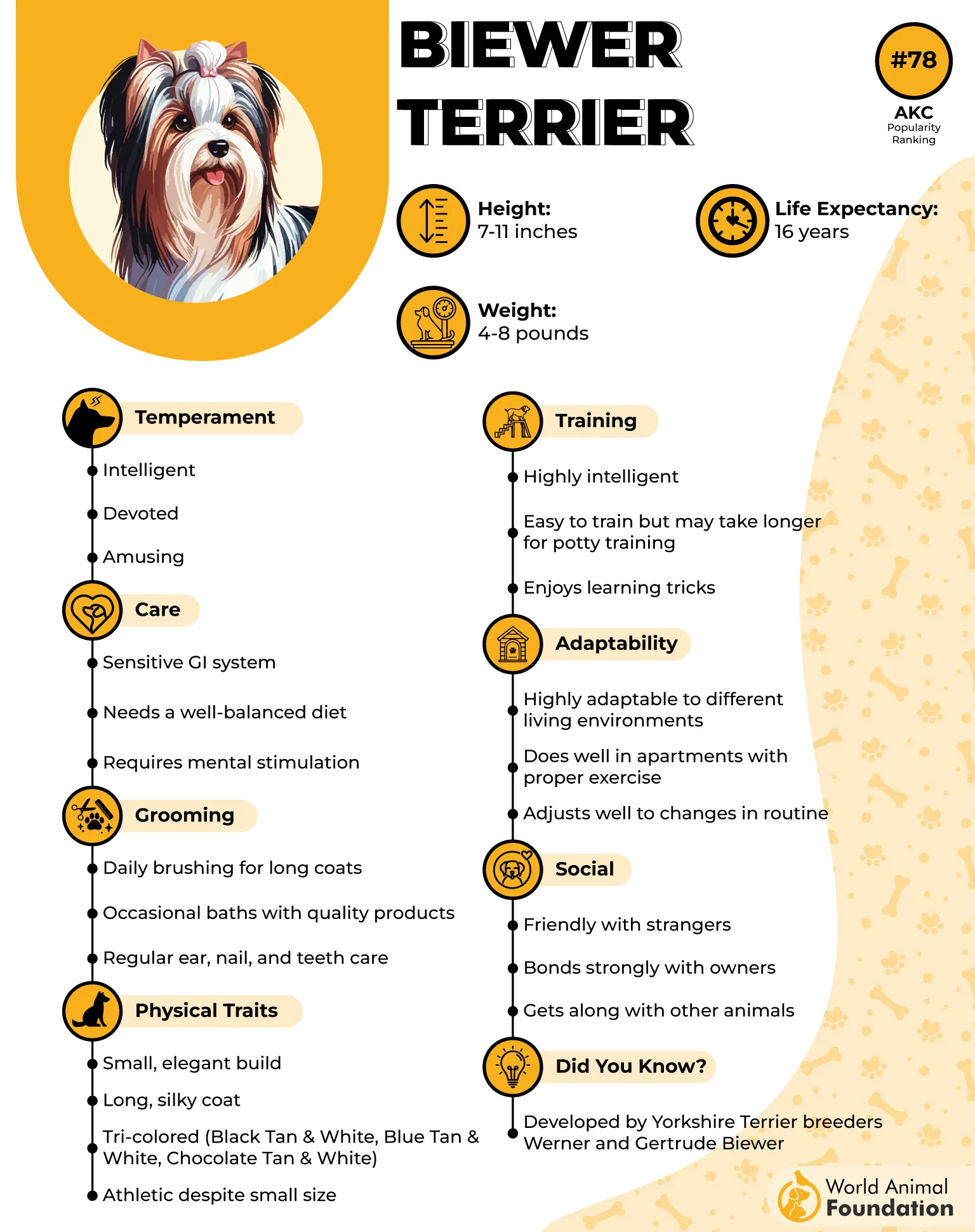
True companion with social intuition
The Biewer develops strong social awareness in close settings. It picks up quickly on shifts in tone and expression, often responding before words are spoken. That’s what makes them naturally compatible as family dogs, especially in calmer households.
Precise grooming, low shedding
Despite their flowing coat, they shed far less than most breeds with a similar appearance. The coat grows continuously and requires regular upkeep to avoid matting, particularly around the ears and underbelly. It’s part of what makes this breed sought-after among allergy-sensitive owners.
4. Bolognese
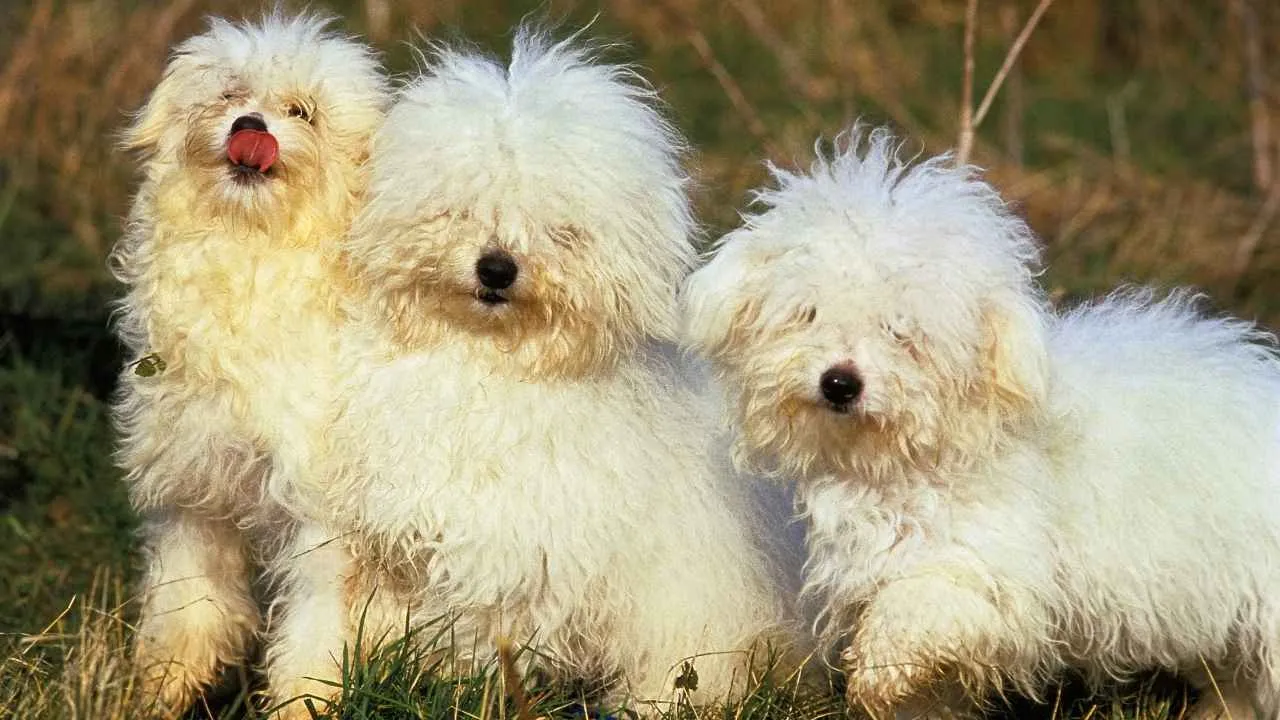
The Bolognese doesn’t crave the spotlight—it bonds deeply with one person and quietly shadows them throughout the day. It watches more than it barks, responding more with body language than noise. That silent loyalty is what sets it apart from louder companion breeds.
Distinct texture, minimal shedding
Though it carries a full, long coat, its hair doesn’t shed like typical fur, making it less messy around the house. The coat needs regular grooming to prevent matting, but it doesn’t carry much odor or dander. The fluff isn’t just for appearance—it insulates surprisingly well.
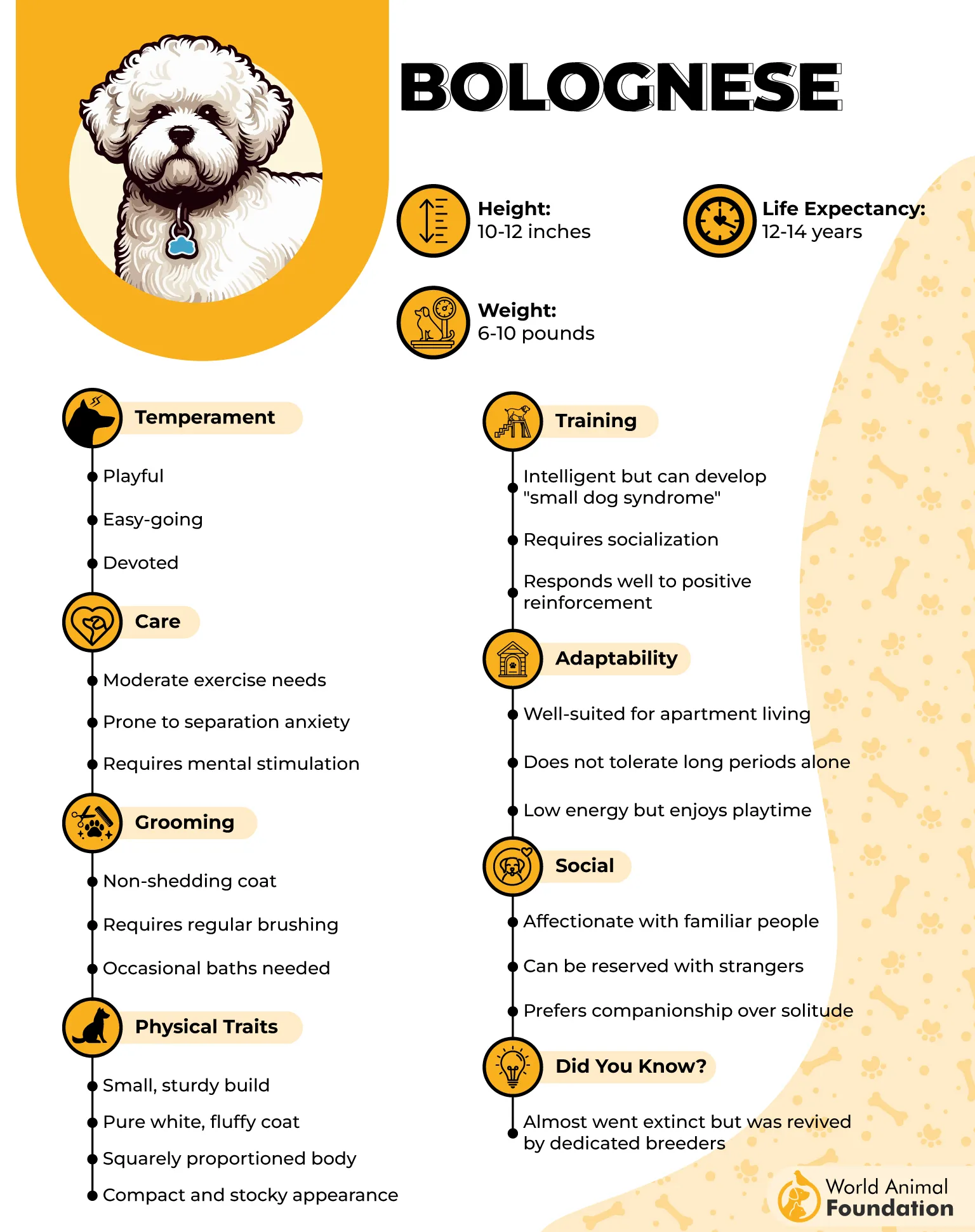
Soft-spoken but full of character
The Bolognese may be gentle, but it carries one of those rare big personalities that doesn’t need volume to stand out. It has strong preferences—where it sleeps, when it plays, how it’s held—and it’ll quietly insist on them. It communicates with intent, not chaos.
Selective with playmates
It usually tolerates other animals as long as they respect its space and pace. Overexcitement or rough play can stress it, so calm companions are a better fit. Even in puppyhood, it tends to prefer routines and quiet corners over fast-paced play.
5. Cesky Terrier
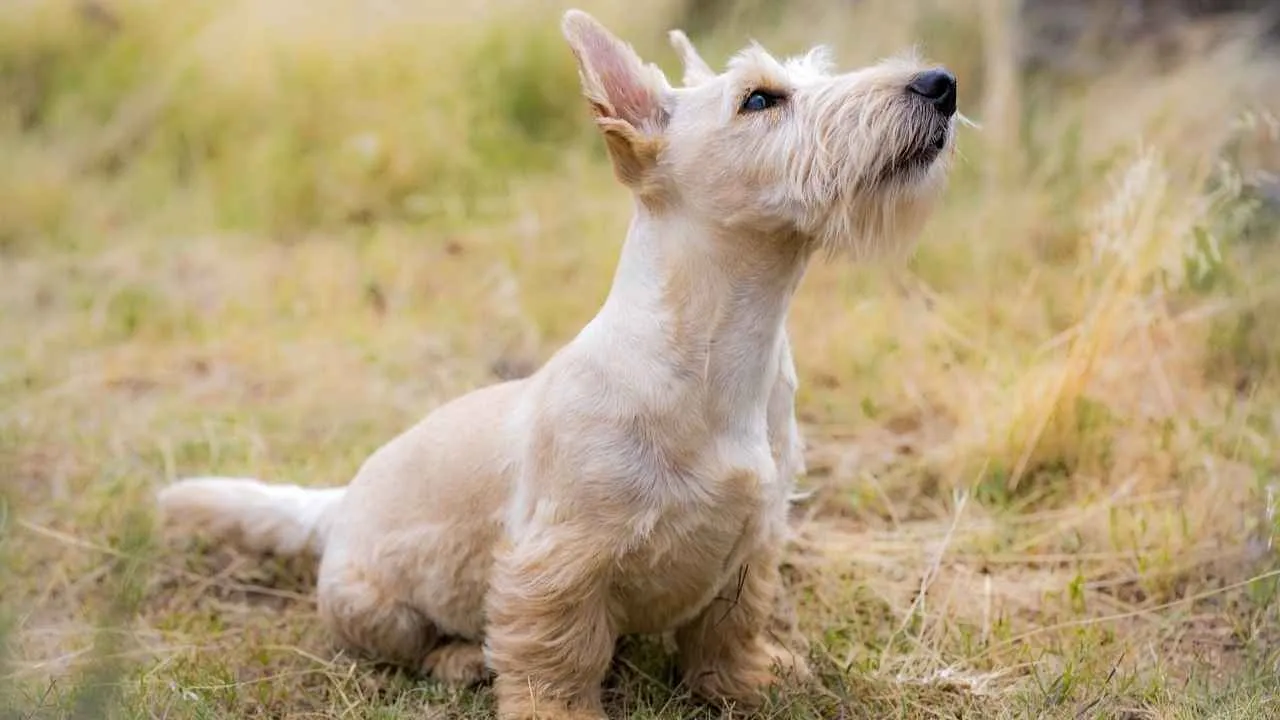
The Cesky Terrier was developed in Czechoslovakia by a geneticist aiming to create a more manageable hunting terrier. It’s the result of careful crosses between Scottish and Sealyham Terriers, making it purpose-built for narrow forest paths and dense cover. That origin still reflects in its focused, steady temperament.
Not what you’d expect at first glance
Its long body, silky coat, and softer expression don’t scream “hunter,” but it was bred to track and flush game from tight underground spaces. Beneath its refined look is a drive for activity and scent-based exploration. The coat isn’t wiry like many terriers—it grows soft and requires regular trimming.
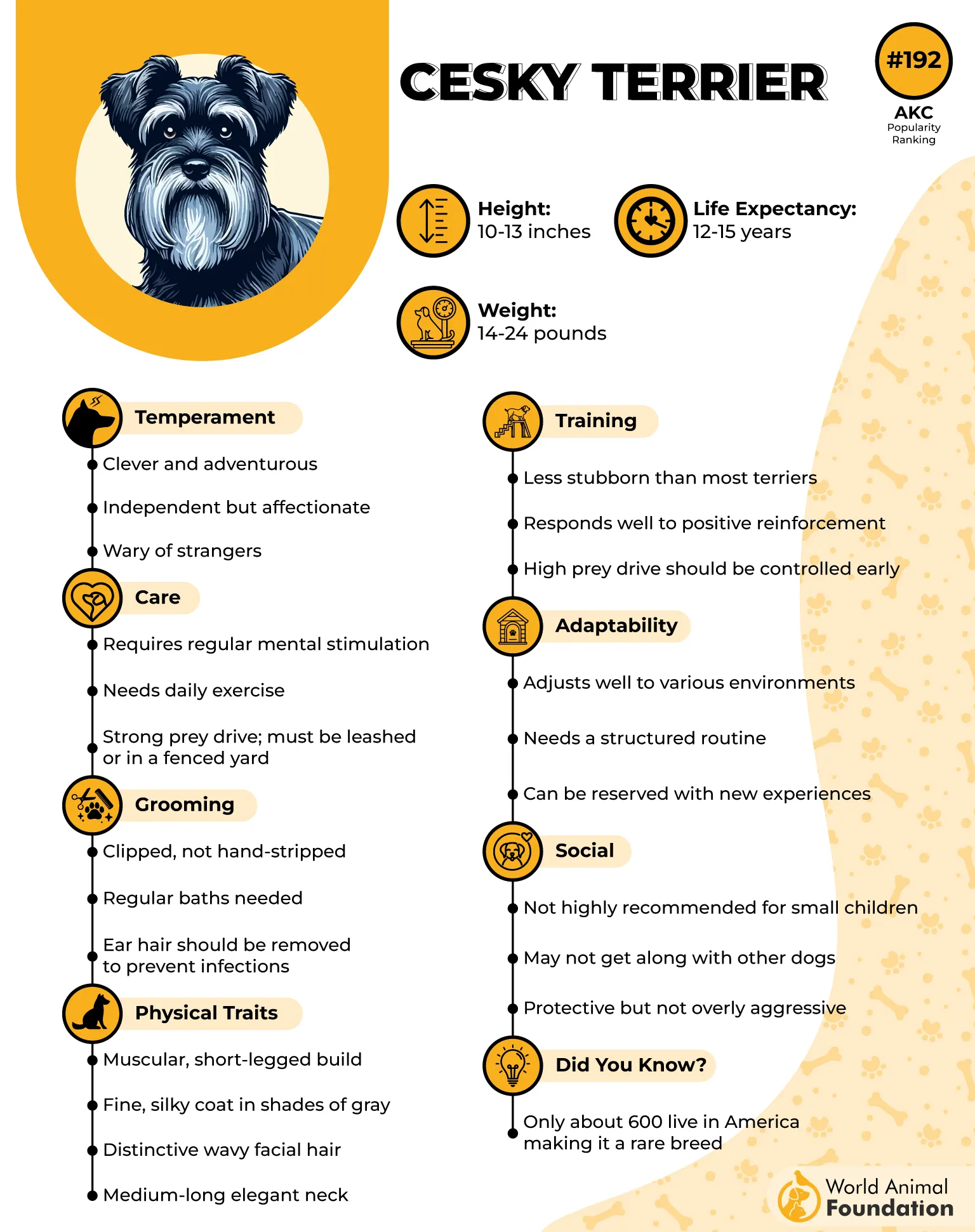
Even-tempered and reserved
It may carry the terrier label, but the Cesky has a noticeably milder presence in the house. Less yappy and reactive than many small breeds, it prefers observing before jumping in. That’s what makes it especially appealing to people looking for a good-natured companion with minimal drama.
Rare and selectively bred
The breed remains a rare sight, with fewer than 600 born annually in some years, as the AKC reported. Its limited numbers are tied to strict breeding oversight and concentrated preservation efforts. That rarity contributes to its reputation as a collector’s favorite among dog enthusiasts.
6. Dandie Dinmont Terrier
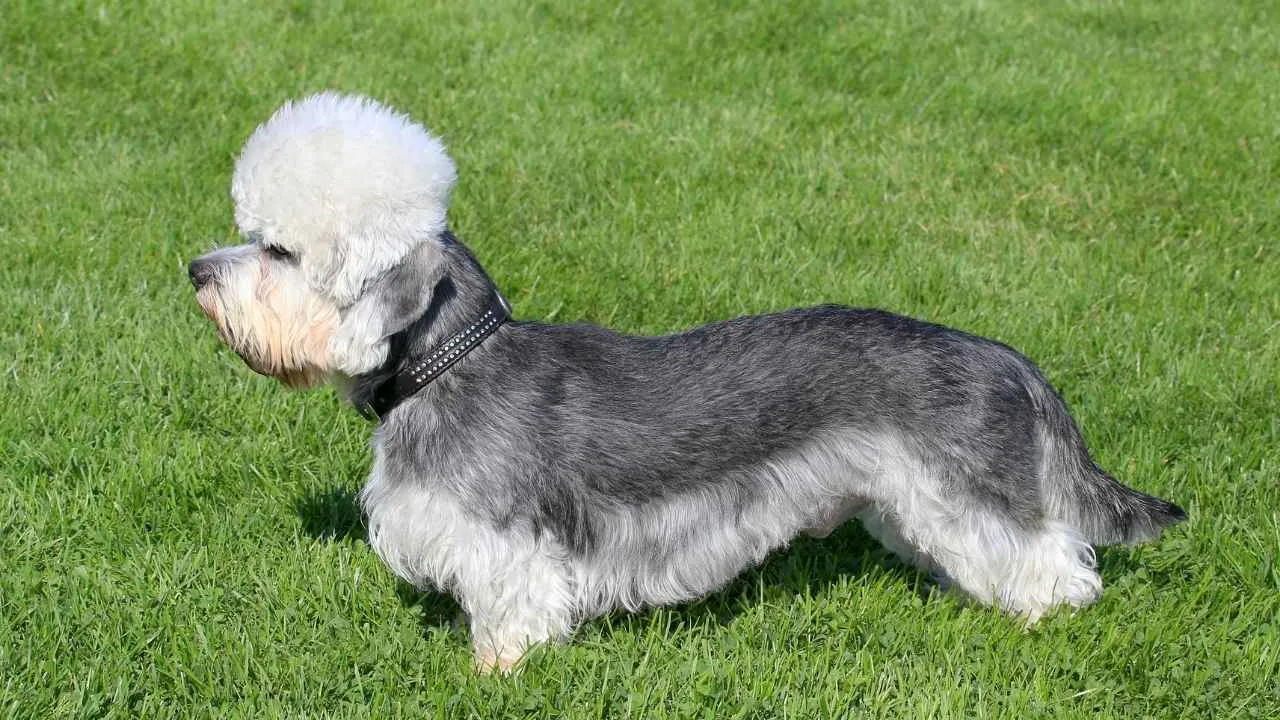
This breed stands out with its long, low-set body and a broad head crowned with a silky topknot—traits rarely seen in small breeds today. Its curved outline isn’t just cosmetic; it contributes to a steady, deliberate gait designed for navigating rough terrain.
Reserved nature, loyal instincts
Dandies aren’t attention-seekers, but they’re deeply loyal and quietly devoted to their family. They’re not the type to bark at every sound—they observe first, react later. Their calm presence often makes them ideal for quieter households that value subtle companionship.
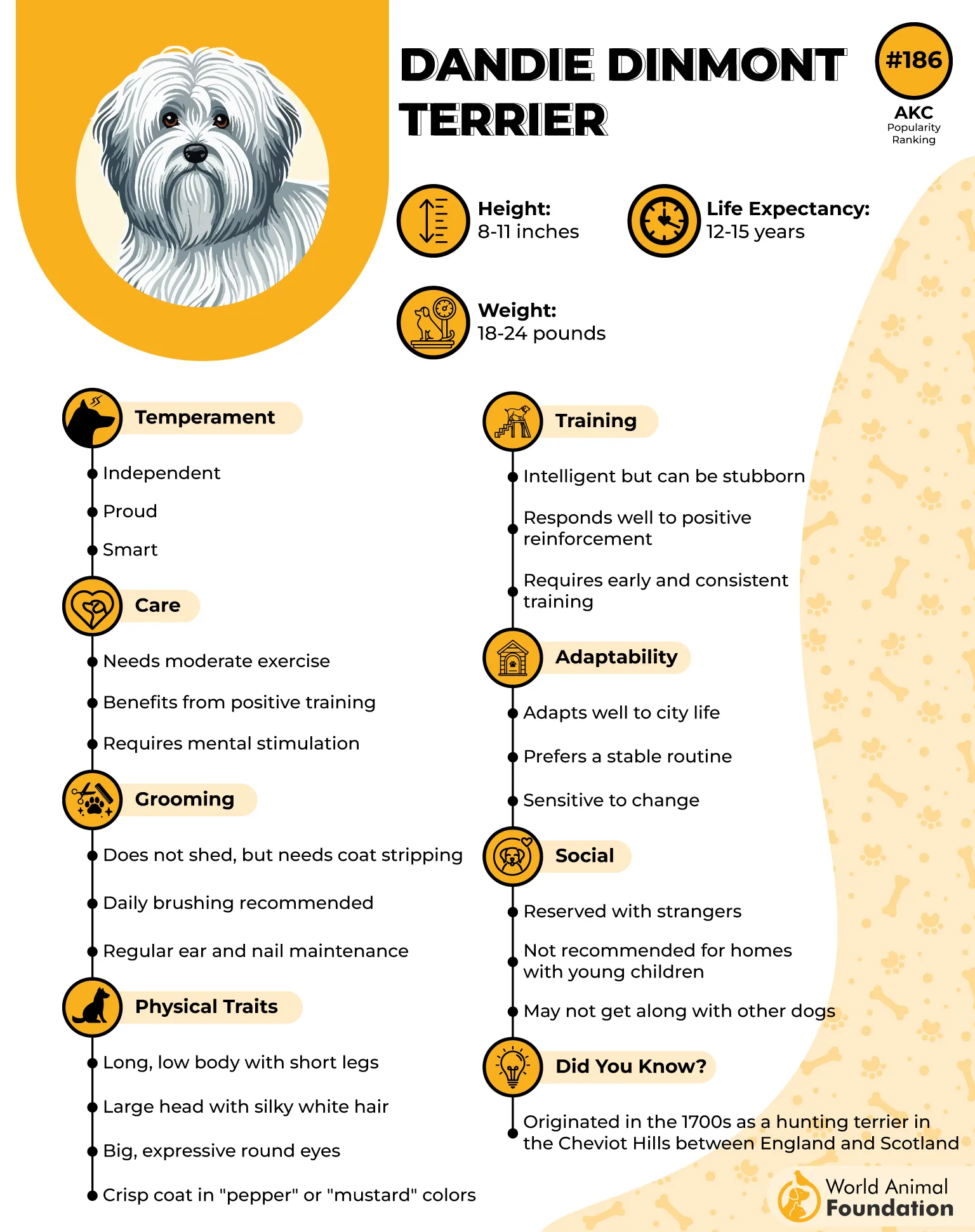
Sharp thinker, selective listener
The Dandie’s intelligence is paired with a self-driven mindset—it often evaluates commands before deciding if they’re worth following. It’s one of those smart breeds that learns quickly but prefers working with a purpose rather than just performing tricks.
Low numbers, deep history
With a lineage traced back to the 1700s and connections to old terrier hunting lines, this rare breed has never been bred for mass popularity. Registrations remain low worldwide, which has kept its original traits intact—stability, strength, and emotional depth.
7. Danish-Swedish Farmdog
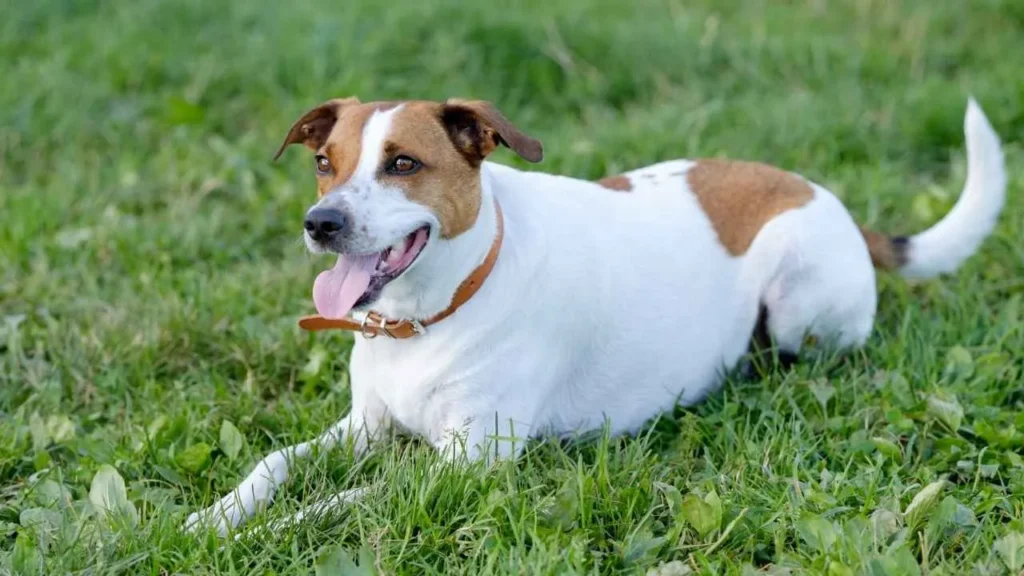
This breed was originally used across Scandinavian farms not just as a helper, but as a multitasker—ratting, herding, even alerting to visitors. It responds to structure, thriving when given tasks or routines to follow. You’ll often find it checking doors, corners, or gathering toys instinctively.
Calm indoors, focused outdoors
While it can spend hours settled quietly beside you, its outdoor focus is intense and deliberate. It doesn’t dart or scatter—it tracks. Its attention locks onto movement, whether it’s following a trail or narrowing in on sound from a distance.
Strong memory and pattern recognition
It remembers routes, routines, and sound cues with minimal reinforcement. One-time exposures to patterns, like where tools or food are stored, are often enough. This mental sharpness shows especially in rural settings where tasks shift but expectations stay consistent.
Ancestral balance of utility and restraint
Its temperament is rooted in centuries of practical use: alert but not loud, energetic but not frantic. It knows when to step back and observe before reacting. Its social style is polite, rarely pushy, and guided more by cues than enthusiasm.
8. Dutch Smoushond
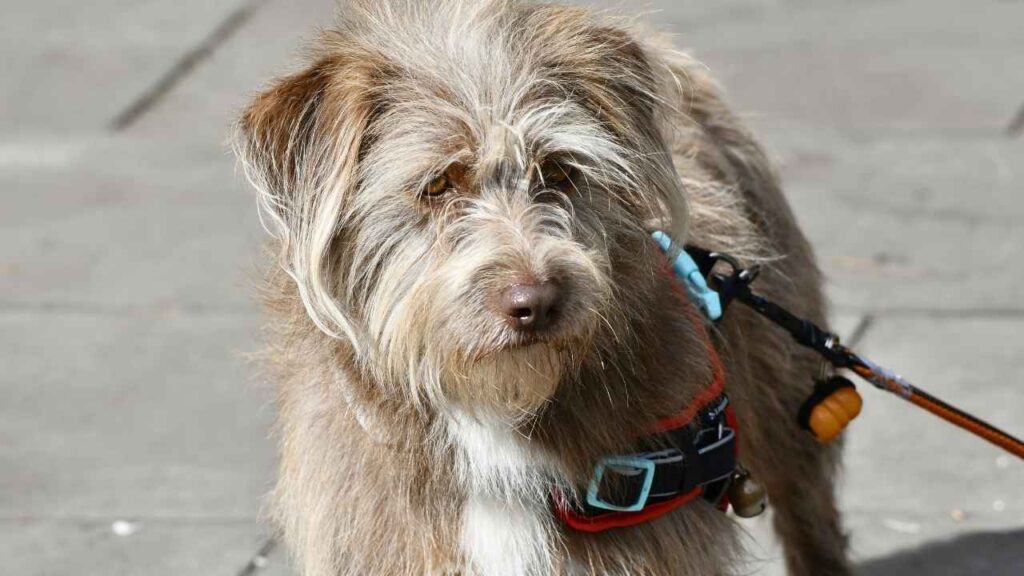
The Dutch Smoushond was originally kept in horse stables across the Netherlands to control vermin, and that working purpose still shapes its behavior. It doesn’t crave attention or crowds—it watches, follows, and stays close to familiar people without demanding much.
Scruffy coat, steady temperament
Its wiry yellow coat doesn’t need shaping or styling—it was made to be functional in dusty, active environments. Even the facial hair grows naturally forward over the eyes, giving it a shaggy, unbothered expression. Its grooming needs are minimal but consistent.
Soft-spoken but not timid
The Smoushond’s bark isn’t loud or frequent, and it rarely seeks to challenge other dogs. Its confidence shows in how it handles unfamiliar spaces with calm interest instead of anxiety. It watches longer than it reacts—more observant than impulsive.
Rare even in its home country
It nearly vanished during the World Wars, and breeders worked quietly to bring it back with careful tracking. Even today, it’s rare to find outside Europe, and even then, usually only through specialty breed networks or preservation programs.
9. Jagdterrier
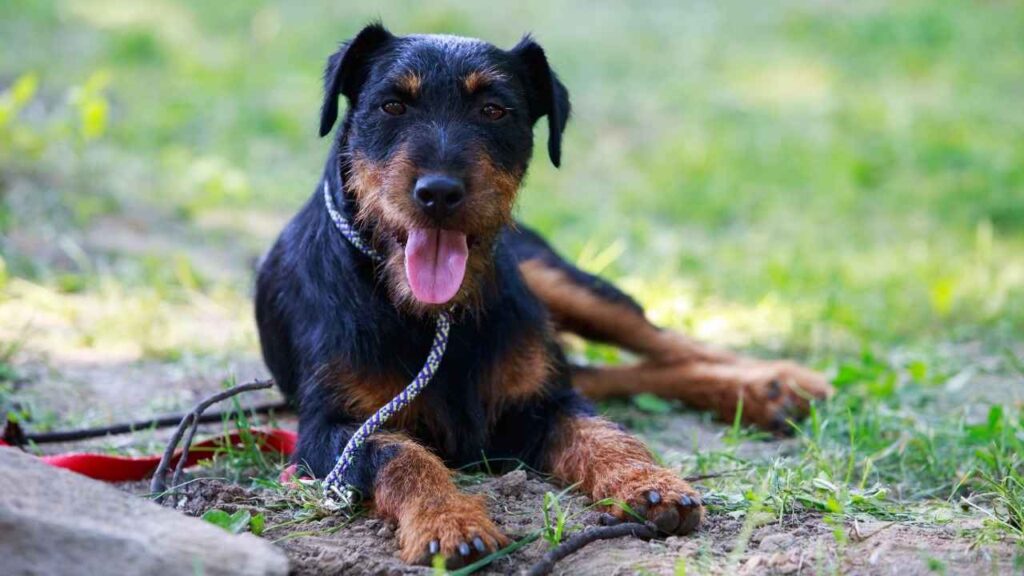
Bred specifically in Germany for hunting underground predators like foxes and badgers, the Jagdterrier’s tenacity is unmatched. Its small frame is lean muscle built for digging, sprinting, and squeezing into tight burrows. It works relentlessly until the job is done.
Mental endurance and focus
This breed isn’t just high-energy—it stays locked in when working, ignoring distractions around it. Even without visible prey, it’ll scan and pace with a hunter’s concentration. Mental fatigue is rare; it thrives on complex, task-oriented activities.
Independent and task-driven
Jagdterriers aren’t crowd-pleasers. They’re problem-solvers who work best with firm direction, not constant praise. When given responsibility, like scent tracking or field training, they stay motivated without relying on external cues.
Not your average companion dog
This breed’s working roots are evident in how it interacts with its surroundings—it assesses, reacts, and moves with purpose. It isn’t the kind of dog that seeks a lap; it looks for terrain, challenge, and purpose. Even indoors, it stays alert and ready.
Conclusion
While working dogs and herding dogs have always had their place in function, rare small breeds often carry just as much spirit in smaller doses. These dogs weren’t bred for show—they were bred for a purpose.
Some helped in the kitchen. Others stood watch in barns. A few even braved cold trails like small sled dogs. Their legacy might not scream from every park bench or commercial, but they’re quietly remarkable. They may not appear under the usual “popular dog breeds” banner, but their unique appearance and character speak volumes.
If you’re considering a dog that fits your life, not the trend, look toward the breeds that move in the opposite direction of the crowd. Just make sure your search starts with a reputable breeder who values the same standards that built these remarkable companions in the first place.


